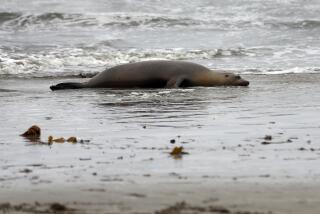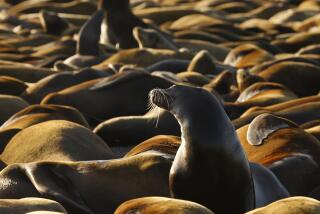Birds of a Feather : South County Volunteers Work Around the Clock to Save Beloved Pelicans
LAGUNA NIGUEL — Hour after hour, prepared with clean towels and feeding tubes, they waited Tuesday for the next arrival of the pelicans.
And when the van finally pulled into the driveway, the small band of volunteers with the Pacific Wildlife Project rushed outside to yank open the doors. Inside, they found a mass of brown and gray feathers, foot-long bills, wings, beady eyes, more wings.
In all, 34 endangered brown pelicans had traveled in the air-conditioned van across the desert to this quiet Orange County neighborhood, refugees of a natural disaster at the Salton Sea.
Twenty-five birds arrived alive. Nine were pronounced dead and laid side by side on the patio.
A deadly outbreak of avian botulism has killed or sickened nearly 3,000 pelicans at the Salton Sea, a gathering spot for many migrating birds. The outbreak at the lake 80 miles northeast of San Diego has surprised and concerned bird experts because of its virulence and the huge die-off it has caused, so massive that an incinerator is kept running around the clock to dispose of carcasses.
But if Linda Evans has her way, the brown pelicans transported to Laguna Niguel will survive.
Evans runs the Pacific Wildlife Project behind tall, gray walls on a quiet street here. She and her veterinarian husband, Richard, are known for their advocacy for pelicans and other troubled wildlife.
So when the birds started dying at the Salton Sea, Evans was called on to help. They received about 30 pelicans Sunday evening and another 30 on Monday.
Wildlife officials report that the illness cannot infect humans. David Klinger, spokesman for the U.S. Fish and Wildlife Service in Portland, Ore., saidthat its exact origins are unknown, but the birds might have ingested the toxin through fish or water.
About 1,000 of the stricken birds at the Salton Sea are brown pelicans, an endangered species that was nearly wiped out by the pesticide DDT.
Evans is relying on a stalwart crew of volunteers to drive the birds from the desert to Laguna Niguel and help nurse them back to health.
The weakest of the pelicans are kept in large cages, some holding two or three birds.
Evans feeds them by hand with a hospital-grade electrolyte fluid in a large syringe attached to a tube. Holding the pelican’s bill in one hand, she uses her other hand to guide the tube down the bird’s fleshy throat.
She seems fearless as she faces these big birds with their long bills, and she laughs as one snaps his bill at her.
“Oh, you’re feeling better, aren’t you, Buster?” she retorts.
She reports she has slept only about five hours in three days. But so far, things are going well. On Tuesday, she was ecstatic when she got the news that an animal shelter in Irvine could provide space for some of her pelicans.
And so far, all of the pelican refugees in her care are surviving.
“I can’t believe no one’s died yet. Some of these kids look real bad,” she said, surveying a roomful of cages.
Some of the weakened birds arriving in the van were not so lucky. The two volunteers who transported the pelicans stopped en route to spray them with water, and the birds traveled with foam bumpers wrapped with sheets to make them more comfortable.
But the Salton Sea botulism is a powerful illness, sapping the birds’ strength and paralyzing them.
As the volunteers unloaded the van Tuesday afternoon, they found both lively, wing-flapping pelicans and weaker ones that could barely lift their heads. Others were stiff, their lifeless wings tight to their bodies.
So like hospital emergency room triage workers, the volunteers divided the birds--the strongest, those needing more care, the dead.
Bruce Evans, a volunteer from Rancho Santa Margarita who drove the birds to Orange County on Tuesday, stooped down inside the van and sorted through the wings and feathers.
“Oh, good, you’re snapping at me. You’re OK,” he told one pelican.
He thought back to the scene at the Salton Sea and said, “This is the positive tip of the iceberg. It really is.”
More to Read
Sign up for Essential California
The most important California stories and recommendations in your inbox every morning.
You may occasionally receive promotional content from the Los Angeles Times.










